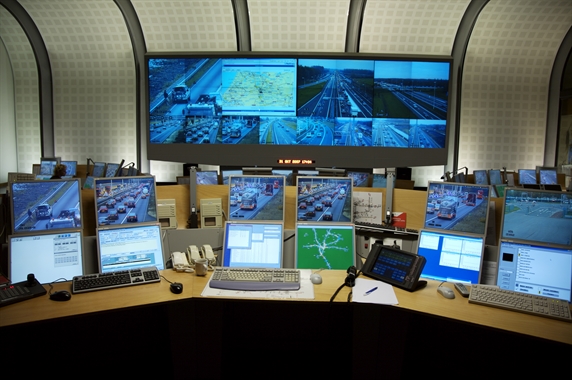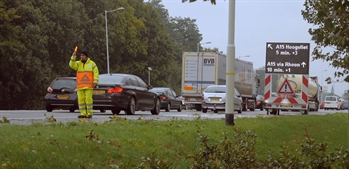Case study Public-private traffic management from the traffic control centre
The province of South Holland is letting market parties take care of traffic management relating to maintenance work. During work on the Hartelbrug near Spijkenisse, responsibility for this lay with Traffic & More. A Traffic & More co-ordinator directed traffic controllers from the traffic control centre in Rhoon. This was done from a workstation right next to the Regional Desk.
At the Regional Desk, road authorities in South Holland work together. The Regional Desk is linked to the camera, DRIP and VRI management systems of various road authorities: Rijkswaterstaat, the Province of South Holland, and the municipalities of Rotterdam and The Hague. Smaller road authorities without their own control centres are also connected to the Regional Desk. In this way, Traffic & More was able to make direct use of all information and camera images from the Province of South Holland, Rijkswaterstaat and the
Municipality of Rotterdam.
This information was transmitted almost in real time to traffic controllers on the street. And vice versa, the information from the traffic controllers outside came via a direct line to the traffic control centre. This made it possible to take measures quickly, by adjusting scenarios for example.
In short, this was an excellent solution with all the characteristics of Smart Mobility:
- maximum pooling of all available information and obtaining a single common operational picture
- a new form of partnership between the market and the authorities. In this way, both could perform their tasks optimally.
Background and aim
In the autumn of 2013, the Province of South Holland carried out work on the Hartelbrug for four weeks. This bridge is part of the N218 and connects the A15 with the island of Voorne-Putten. The Hartelbrug is a very important link for that area. During the work, one lane was available to traffic in each direction instead of the regular two lanes.
The new form of public-private traffic management had to ensure short lines of communication between the various parties. Allowing the market party to sit in the traffic control centre led to smooth co-operation. This made it possible to jointly make quick, smart decisions that would have a positive effect on traffic flow.
Scope and effect
During the work there was a lot of disruption on the road. By inviting a market party to the Regional Desk of the traffic control centre it was possible to:
- gain better and faster insight into the location and origin of the disruption
- immediately take the right measures to reduce the disruption as much as possible
An example of this was a physical barrier on the road where road users could pass on both sides during the work. However, the traffic largely used one lane, causing a queue and a dangerous tailback onto the A15. This problem was quickly detected in the traffic control centre using Rijkswaterstaat's camera management system. A traffic controller was immediately sent to this situation, and directed the traffic to use both lanes. The traffic jam cleared up quickly. Afterwards, we jointly examined how the barrier could be placed so that it was clearer to road users that they could use both lanes.

Points for attention
- Responsibility of the market party: the market party deployed in the traffic control centre must be capable of carrying out the work and must also have the will to take on this type of innovative partnership. The market party must be distanced from other activities taking place in the traffic control centre.
- Operability of the market party: ensure that there is an open Internet connection in the traffic control centre so that the market party can run its own systems. Rijkswaterstaat's systems generally do not have an open Internet connection due to ICT security. Setting up a Wi-Fi connection is a pragmatic solution that can bypass Rijkswaterstaat's system.
- The Regional Desk as an ideal location: the deployment as described in this fact sheet was ideally suited to the Regional Desk at the traffic control centre in Rhoon. This desk, jointly organised by the partnership, is the only place where the information from all road authorities is available at a single location.
- Core traffic control centre team: make sure that as few people as possible are employed by both the private party and the Regional Desk. This allows the parties to get to know each other personally and it creates trust.
- High urgency: there was no need to ‘convince’ the traffic control centre of the necessity of this measure. The sense of urgency was high and there were no additional costs involved in accommodating the Traffic & More co-ordinator.
Can the measure be deployed more broadly?
Since its actual use in 2013 as described in this fact sheet, there have been several other examples of public-private traffic management, in the traffic control centre, too. For instance, similar testing was carried out during the Nuclear Security Summit (NSS) in 2014.
In the Field test in Amsterdam, in Amsterdam Zuidoost in 2016, large-scale testing involving private traffic management was carried out. This created a public-private partnership, which included management of traffic accessing and leaving events. This went substantially further than instructing traffic controllers and it is expected that traffic management (or some of its elements) will be left to market parties more often in the future. Use during actual road works as described in this fact sheet is thus a great example.

